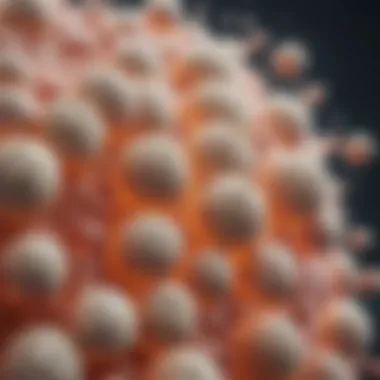Understanding MRSA Skin Infections: Management & Insights


Intro
Methicillin-resistant Staphylococcus aureus (MRSA) skin infections represent a significant medical challenge. The emergence of resistance to methicillin and other beta-lactam antibiotics has made these infections difficult to treat. MRSA infections generally occur in healthcare settings but are increasingly prevalent in the community. Understanding the nature of MRSA, as well as its implications for treatment and prevention, is essential for healthcare providers, patients, and the general public.
In this article, we provide a thorough examination of MRSA skin infections. We will discuss their etiology, symptoms, methods for diagnosis, treatment options available, and preventive strategies. The discussion integrates recent scientific research with practical advice, aiming to equip readers with essential knowledge for managing MRSA effectively.
Foreword to MRSA Skin Infections
Methicillin-resistant Staphylococcus aureus (MRSA) skin infections pose considerable challenges in both healthcare and community settings. Understanding MRSA is essential not just for healthcare professionals, but also for patients and caregivers. Knowledge of MRSA allows for better management of the infections, which can lead to improved outcomes. MRSA infections have a unique position in healthcare due to their antibiotic resistance, making them a significant concern for public health.
Being informed about the characteristics of MRSA can facilitate appropriate treatment approaches. This section discusses the nature of MRSA, its history, and its types, which are crucial for understanding how these infections spread and persist.
What is MRSA?
MRSA stands for Methicillin-resistant Staphylococcus aureus, a type of bacteria resistant to certain antibiotics, including methicillin. This resistance makes infections harder to treat compared to regular Staphylococcus aureus. Individuals who are most at risk often have weakened immune systems or existing health conditions. MRSA can cause various skin infections, which might appear as red, swollen, or pus-filled areas on the skin. It is essential to recognize these signs early to prevent complications.
History and Epidemiology of MRSA
The history of MRSA dates back to the 1960s when it was first identified in hospital settings. Over the years, its prevalence has increased, particularly among individuals in healthcare environments. The epidemiology of MRSA shows its two main strains: healthcare-associated and community-associated. The rise in antibiotic resistance has created a complex landscape for infection control, making it crucial to understand how MRSA spreads and the populations most affected.
Types of MRSA
Healthcare-associated MRSA
Healthcare-associated MRSA, often referred to as HA-MRSA, primarily affects patients in healthcare settings, such as hospitals and nursing homes. A key characteristic of HA-MRSA is its ability to spread among individuals with weakened immune systems. This aspect makes it crucial in limiting outbreaks in health facilities.
One unique feature of HA-MRSA is its high rate of antibiotic resistance. This resistance often leads to more complex treatment regimens, making it vital for healthcare providers to be diligent in infection control measures. Although treatment may be challenging, knowledge about HA-MRSA allows healthcare professionals to develop effective management strategies.
Community-associated MRSA
Community-associated MRSA, commonly known as CA-MRSA, emerges in healthy individuals, typically in the community rather than healthcare environments. A distinguishing characteristic of CA-MRSA is that it often leads to skin and soft tissue infections, which can be more accessible to treat when caught early. This type of MRSA generally occurs in populations engaged in close contact activities, such as athletes or children in schools.
The unique feature of CA-MRSA lies in its risk factors and transmission routes, which differ from those of HA-MRSA. However, although CA-MRSA infections are often milder, they can still cause significant health issues. Understanding the nature of CA-MRSA is crucial for implementing effective prevention strategies.
Pathophysiology of MRSA Skin Infections
Understanding the pathophysiology of MRSA skin infections is crucial for effective management and treatment. This section explains the mechanisms that facilitate the disease and identifies risk factors that contribute to the spread of this infection. The knowledge gained from this exploration informs healthcare strategies and preventive measures.
Mechanism of Infection
Methicillin-resistant Staphylococcus aureus (MRSA) primarily causes skin infections through skin breaks or surgical wounds. The bacteria enter the body when the skin barrier is compromised, allowing them to colonize and multiply. They are particularly virulent due to the presence of various virulence factors, such as adhesins that facilitate attachment to host tissues.
Once inside, MRSA can produce toxins that damage tissue and evade the immune response. For example, certain proteins interfere with phagocytosis, enabling the bacteria to persist despite the body’s defenses. The result is often localized pain, redness, and swelling, forming a significant component of MRSA skin infections.
Risk Factors for MRSA Infection
Identifying risk factors for MRSA infection helps in understanding how the bacteria spread and which populations are more susceptible. The following subcategories explore essential elements of risk.
Personal hygiene practices
Personal hygiene plays a critical role in preventing MRSA infections. Good hygiene practices, such as regular hand washing and timely treatment of cuts, reduce bacterial exposure and minimize entry points for infection. Individuals who neglect hygiene may face higher risks of acquiring MRSA, especially in close-contact settings like gyms or locker rooms.
The importance of personal hygiene is underscored by its simplicity. It does not require advanced medical knowledge, making it an accessible preventive measure. However, a unique challenge exists where access to clean water and sanitation may vary, impacting the effectiveness of these practices.
Environmental considerations
The environment significantly impacts the dynamics of MRSA transmission. Facilities like hospitals, where patients are often immunocompromised, can become breeding grounds for resistant strains. High-touch surfaces and equipment that are not regularly disinfected pose immense risks. Understanding the surfaces and materials that facilitate MRSA persistence is critical for infection control.
Environmental factors are favorable because they can be modified through proper cleaning protocols and maintenance of hygiene standards. However, inconsistent implementation of these measures can lead to outbreaks.
Patient demographics


Patient demographics indicate vulnerability to MRSA infections. Certain populations, including older adults or those with chronic diseases, are at increased risk due to weakened immune systems. Furthermore, socioeconomic factors often influence access to healthcare resources, affecting preventive measures.
The demographic aspect is beneficial for identifying high-risk groups for targeted prevention strategies. However, attention must be paid to ensuring that interventions reach all segments of the population equitably.
In summary, a thorough understanding of the pathophysiology of MRSA skin infections enhances awareness and fosters better prevention and treatment strategies.
Symptoms and Diagnosis of MRSA Skin Infections
Understanding the symptoms and the diagnostic processes of MRSA skin infections is crucial. Accurately identifying these symptoms can lead to prompt and effective treatment. Early diagnosis can often prevent severe complications. Knowledge of symptoms enables better patient education and awareness, which can reduce the spread and impact of MRSA in communities and healthcare settings.
Common Symptoms of MRSA Skin Infections
Skin lesions
Skin lesions are usually the most recognizable symptom of MRSA skin infections. They often appear as red, swollen bumps or pimples. Such lesions may be painful and warm to the touch, often resembling a spider bite or boil.
The presence of these lesions is a major focus in the discussions surrounding MRSA for several reasons. First, they can indicate a localized infection that requires immediate medical attention. Second, their distinctive appearance helps in the recognition of potential MRSA cases before they become serious. However, distinguishing them from other skin conditions can be challenging. Being aware of their key characteristics is important for effective recognition and response. While most lesions may resolve, untreated MRSA infections can lead to significant health issues.
Fever and other systemic signs
Fever and systemic signs are crucial indicators of a potential MRSA infection. When the body is fighting infections, fever often occurs as part of the immune response. This can serve as a warning signal of an underlying issue, even if skin symptoms are not apparent. Fever can sometimes accompany fatigue, malaise, and chills.
The significance of these signs lies in their ability to signal more widespread infection, especially if accompanied by skin lesions. They provide a broader picture of the patient’s health status. In patients with severe infections, this can lead to necessary interventions that might not have been initiated based solely on skin symptoms. Understanding systemic signs complements the knowledge required in managing MRSA infections.
Diagnostic Procedures
Effective diagnosis of MRSA skin infections involves both physical methods and laboratory testing. Proper diagnostic procedures are essential for ensuring the right treatment is provided. Misdiagnosis can lead to ineffective treatments and complications.
Physical examination
A physical examination plays a fundamental role in diagnosing MRSA skin infections. During this examination, healthcare professionals can assess the severity of the symptoms and identify any skin lesions. The examination allows for visual confirmation of symptoms and evaluation of the lesion characteristics, such as size, color, and surrounding tissue condition.
This method is particularly beneficial because it can be performed quickly in various healthcare settings. However, it may not always provide comprehensive information regarding the cause of the infection, as some mild cases might not present clear lesions. Still, it's an important first step in the diagnostics process.
Laboratory tests
Laboratory tests are critical for confirming the diagnosis of MRSA. They usually include cultures taken from the infected area, which can identify the specific bacteria responsible for the infection. This is essential for determining the appropriate treatment plan.
One key characteristic of laboratory tests is their ability to provide precise identification of MRSA. This leads to more effective management of the infection. While laboratory testing can be time-consuming due to the need for incubation, it represents a necessary step in ensuring that treatment aligns with the specific strain of the bacteria. Being aware of the results enables clinicians to respond effectively to the infection and adjust treatment as necessary.
Accurate and timely diagnosis is paramount in managing MRSA infections effectively, reducing the risk of complications, and guiding appropriate treatment strategies.
Treatment Options for MRSA Skin Infections
Treatment options for MRSA skin infections are vital to discuss due to the unique nature of these infections. MRSA, or Methicillin-resistant Staphylococcus aureus, presents challenges that necessitate a tailored approach. Understanding the most effective treatment methods helps in managing symptoms and preventing complications. This includes a combination of antibiotic and non-antibiotic treatments, ensuring comprehensive care.
Antibiotic Treatments
Antibiotics play a crucial role in managing MRSA skin infections. They target the bacteria directly, providing relief from symptoms and preventing the spread of infection.
Types of antibiotics effective against MRSA
Several types of antibiotics are effective against MRSA. These include vancomycin, linezolid, and daptomycin. Each antibiotic has specific properties that make it suitable for treating MRSA.
- Vancomycin: It is often considered the first line of treatment. Vancomycin is a powerful antibiotic specifically designed to combat gram-positive bacteria, including MRSA.
- Linezolid: Another option, which is beneficial for patients who may be resistant to vancomycin. Linezolid has a unique mechanism of action, inhibiting bacteria from synthesizing proteins necessary for their growth.
- Daptomycin: This antibiotic is effective in cases of complicated skin infections caused by MRSA. Its unique feature is that it disrupts the bacterial cell membrane, leading to cell death.
These antibiotics are often chosen based on their effectiveness and the patient's medical history. However, they also have disadvantages, including potential side effects and the risk of developing antibiotic resistance.
Challenges in antibiotic use
While antibiotics are crucial, there are challenges to consider when using them to treat MRSA infections. Primarily, the rise of antibiotic resistance complicates treatment strategies. Continuous exposure to antibiotics can lead bacteria to develop resistance.
- Resistance Development: This occurs when bacteria change in response to the use of these medications. For example, if a treatment fails, alternatives may be limited.
- Side Effects: Antibiotics can cause side effects ranging from gastrointestinal issues to potential impacts on kidney function. This adds another layer of complexity to the decision-making process.


Medical professionals need to assess the risks and benefits when prescribing antibiotics. Ensuring effective management of MRSA while mitigating resistance is a challenging balance to achieve.
Non-Antibiotic Treatments
Non-antibiotic treatments complement antibiotic therapy, addressing MRSA skin infections from a holistic perspective. These treatments aid in both recovery and prevention of recurrence.
Wound care practices
Proper wound care is essential in managing MRSA skin infections. It involves cleaning and dressing wounds to prevent further infection.
- Cleanliness: Keeping wounds clean minimizes the risk of additional bacterial growth. Effective cleaning agents can include saline solutions, which are gentle yet effective.
- Dressing: Using appropriate dressings can provide a barrier against further contamination while keeping the wound moist, which promotes healing.
Taking these measures seriously greatly helps reduce complications associated with MRSA skin infections.
Topical antiseptics
Topical antiseptics are another valuable tool in managing MRSA skin infections. These agents help by killing bacteria or inhibiting their growth directly at the site of infection.
- Chlorhexidine: It is one of the most common antiseptics used. It is effective in reducing skin flora, thus lowering the infection risk.
- Bacitracin: This ointment is often used for its effectiveness against gram-positive bacteria, including MRSA.
However, there are some limitations. Overuse of topical antiseptics can irritate the skin, and they may not penetrate deeper infections. Therefore, it’s important to combine these treatments with broader management strategies.
Being aware of these treatment options allows for better outcomes in managing MRSA skin infections, aiding individuals in recovery while addressing the public health challenge of antibiotic resistance.
Prevention of MRSA Skin Infections
Preventing MRSA skin infections is crucial for maintaining public health and ensuring patient safety in various environments. This section emphasizes the significance of adopting preventive measures to reduce the transmission of Methicillin-resistant Staphylococcus aureus and avoid potential outbreaks. A multifaceted approach, involving hygiene practices, healthcare protocols, and community engagement, can greatly diminish the risk of infection. This proactive strategy enhances not only individual well-being but also contributes positively to broader health outcomes.
Hygiene Measures
Good personal hygiene is essential in preventing MRSA infections. Regular hand washing is one of the simplest yet most effective methods to eliminate harmful bacteria. Using soap and water, or alcohol-based hand sanitizers when soap is not available, can significantly lower the risk of transmission.
Additionally, individuals should avoid sharing personal items such as towels, razors, or athletic equipment. Keeping wounds covered and clean is also important, as it prevents exposure to bacteria. Educating individuals about proper hygiene practices promotes accountability and fosters a culture of health awareness.
Strategies in Healthcare Settings
Strategies adopted in healthcare settings play a vital role in the prevention of MRSA skin infections. It is essential for healthcare providers to enforce strict infection control protocols. These protocols typically include policies on hand hygiene, the use of personal protective equipment, and environmental cleaning.
Infection control protocols
Infection control protocols are fundamentally aimed at preventing the spread of MRSA within healthcare facilities. A key characteristic of these protocols is their systematic approach to identifying potential sources of infection and mitigating risks. The benefit of such protocols lies in their ability to standardize practices across healthcare settings, reducing variability in infection rates.
A unique feature of effective infection control protocols is continuous training for healthcare staff. This ensures that all personnel are aware of the latest best practices and are prepared to implement them consistently. However, the challenge lies in adherence; maintaining compliance with these protocols requires ongoing diligence and monitoring.
Patient education
Patient education is equally important in preventing MRSA skin infections. It equips patients with the knowledge they need to protect themselves and encourages them to be proactive in their health management. The key characteristic of patient education is that it empowers individuals, giving them a sense of control over their health choices. This is particularly beneficial in reducing the fear and stigma often associated with MRSA.
An effective patient education program includes clear, accessible information on what MRSA is, how it spreads, and ways to prevent infection. While the advantages of patient education are significant, challenges remain, such as ensuring that all patients receive the educational materials and understand their content thoroughly.
Community-Based Prevention
Community-based prevention strategies are essential for curtailing MRSA skin infections beyond healthcare settings. Engaging the community can raise awareness and promote adherence to personal hygiene practices. Initiatives such as workshops or informational sessions in schools and community centers can disseminate valuable knowledge on MRSA. Likewise, fostering partnerships with local organizations can enhance outreach efforts, making prevention a shared goal among diverse populations.
Complications Associated with MRSA Skin Infections
Understanding the complications that arise from MRSA skin infections is critical, as it shapes the clinical management and patient outcomes. The potential for complications can escalate quickly, especially when MRSA accesses deeper layers of skin or enters the bloodstream.
Recognition of these complications is vital for effective treatment. Health care professionals must be aware of the risks, which can encompass severe systemic conditions that necessitate swift intervention. Complications often extend beyond local symptoms, demonstrating the infection’s capacity to affect the entire body.
Sepsis and Systemic Infections


Sepsis is a severe reaction to infection that can be life-threatening. In the case of MRSA, the bacteria can transition from localized skin infection to a systemic infection. This occurs when the bacterium enters the bloodstream.
Risk factors for developing sepsis from MRSA include:
- Weakened immune systems: Patients with chronic illnesses or those on immunosuppressive therapy are at increased risk.
- Delayed treatment: The longer an infection persists untreated, the higher the likelihood of systemic spread.
- Invasive procedures: Surgeries that introduce pathways for bacteria to enter can trigger systemic infections.
Symptoms of sepsis may include:
- Rapid heart rate
- Fever or low body temperature
- Confusion or disorientation
- Shortness of breath
Patients experiencing these signs should seek medical help immediately, as sepsis can escalate to septic shock, which involves a drastic drop in blood pressure and may lead to organ failure.
"Timely recognition and management of sepsis can significantly enhance survival rates."
Long-term Consequences
Long-term effects of MRSA skin infections can vary. Some individuals who suffer from severe infections may experience complications that persist long after the initial infection has been treated.
Common long-term consequences include:
- Chronic pain or discomfort in affected areas.
- Recurrent skin infections, as prior infections may make a person more susceptible to future ones.
- Scarring: Deep infections may lead to permanent skin changes or scars.
- Psychological impacts: The stress and anxiety stemming from a significant health issue can lead to mental health challenges.
Understanding these long-term consequences is important for a patient’s holistic treatment plan. Continuous follow-up care may help manage lingering symptoms and improve quality of life.
In summary, recognizing complications associated with MRSA skin infections is paramount. Sepsis and the array of potential long-term effects necessitate a thorough approach to both treatment and prevention, ensuring that patient outcomes are optimized.
Current Research and Developments in MRSA Treatment
The importance of monitoring and advancing research into Methicillin-resistant Staphylococcus aureus (MRSA) cannot be overstated. It remains a significant challenge in medical settings and communities worldwide. Continuous research aims to address the complexities related to MRSA, particularly regarding its resistance to standard treatments. Emerging therapies and vaccinations are essential for tightening our grip on this public health concern.
Emerging Antibiotics and Therapies
Research is focused on developing new antibiotics that effectively combat MRSA. Current antibiotics, while effective, face challenges due to the bacteria’s resistance mechanisms. Some promising candidates include new synthetic compounds and antibiotic combinations that could restore effectiveness against MRSA.
Ongoing studies investigate existing drugs, like daptomycin and linezolid, to determine their efficacy in different contexts. Clinical trials are vital to establish safety and effectiveness while considering pharmacokinetics. The exploration of non-antibiotic alternatives, such as bacteriophage therapy, also presents an exciting avenue. This technique could selectively kill MRSA strains without harming beneficial bacteria.
"The ongoing development of new antibiotics is crucial in our fight against MRSA, as the existing arsenal is becoming less effective due to resistance."
Vaccines in Development
The development of vaccines provides another front in the battle against MRSA. The immune response generated by vaccines can protect individuals from infection, potentially reducing the incidence of MRSA altogether. Research initiatives prioritize identifying the most effective antigens, leading to vaccine candidates.
Several candidates are undergoing preclinical and clinical trials. The objective is to evaluate not only effectiveness but also safety and tolerability in the patient population. A successful vaccine could significantly reshape preventive strategies in healthcare and community settings.
In summary, understanding current research and developments in MRSA treatment is vital for public health. Both new antibiotics and vaccine developments hold promise in combating this persistent pathogen effectively.
Epilogue
The conclusion serves as a vital component of this article, synthesizing the detailed information presented on MRSA skin infections. It underscores the significance of understanding this public health issue, particularly given the rising incidence of antibiotic-resistant infections. This section not only summarizes the key findings but also highlights their implications for both healthcare practice and community awareness.
By reiterating the critical points, the conclusion reinforces the importance of effective management strategies for MRSA. A clear understanding of symptoms, preventive measures, and treatment options can empower both healthcare providers and patients. Thus, proper education can lead to better outcomes and reduce the spread of MRSA in various settings.
Moreover, the conclusion emphasizes the urgency of addressing MRSA through ongoing research and advancements in treatment. As new therapies emerge and knowledge expands, staying informed allows healthcare professionals and researchers to craft effective protocols that align with the evolving landscape of MRSA management.
"A well-informed approach is crucial to combatting MRSA effectively."
Ultimately, this concluding section urges a proactive stance on MRSA, highlighting the community's role alongside healthcare professionals in curtailing the impact of these skin infections.
Summary of Key Points
- MRSA Overview: Methicillin-resistant Staphylococcus aureus presents significant challenges in both healthcare and community settings due to its resistance to standard antibiotics.
- Symptoms: Early recognition of MRSA skin infection symptoms, which typically include red, swollen lesions and systemic signs such as fever, is essential for prompt treatment.
- Diagnostic Procedures: Effective diagnosis involves thorough physical examinations and laboratory tests to confirm MRSA presence.
- Treatment Options: A combination of antibiotic and non-antibiotic strategies can be employed, with attention to challenges related to antibiotic resistance.
- Prevention: Ongoing emphasis on hygiene, infection control protocols in healthcare settings, and community education is necessary to diminish the risk of MRSA transmission.
- Complications: Understanding potential complications, including sepsis, is crucial to prevent serious health outcomes.
- Current Research: Ongoing developments in antibiotic therapies and vaccines may offer new directions, emphasizing the need for continued investigation.
Future Directions in MRSA Research
The future of MRSA research is promising yet challenging. As antibiotic resistance escalates, it is increasingly important to develop novel approaches to tackle MRSA infections. Future research may focus on the following areas:
- Developing New Antibiotics: The search for new antibiotics that can effectively target MRSA is critical. Research should prioritize molecules that evade existing resistance mechanisms.
- Alternative Therapies: Investigating adjunct therapies, such as bacteriophage therapy or immunotherapy, may provide alternative treatment pathways and reduce reliance on traditional antibiotics.
- Vaccine Development: Continued research into the efficacy of vaccines against MRSA is crucial in preventing these infections before they occur.
- Genomic Studies: Advances in genomics may unveil insights into MRSA strains, offering potential for personalized medical approaches based on genetic data.
- Public Health Initiatives: Research that evaluates the effectiveness of educational programs and community-based strategies will be instrumental in reducing MRSA rates.
Collectively, these future directions highlight the need for a multifaceted approach in addressing MRSA. Fostering collaboration between researchers, healthcare providers, and public health officials will be essential to navigate the complexities of MRSA and its treatment.







